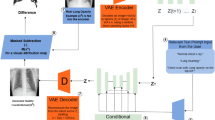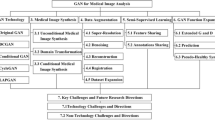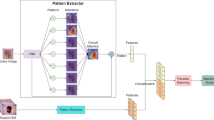Abstract
Some pixels of an input image have thick information and give insights about a particular category during classification decisions. Visualization of these pixels is a well-studied problem in computer vision, called visual attribution (VA), which helps radiologists to recognize abnormalities and identify a particular disease in the medical image. In recent years, several classification-based techniques for domain-specific attribute visualization have been proposed, but these techniques can only highlight a small subset of most discriminative features. Therefore, their generated VA maps are inadequate to visualize all effects in an input image. Due to recent advancements in generative models, generative model-based VA techniques are introduced which generate efficient VA maps and visualize all affected regions. To deal the issue, generative adversarial network-based VA techniques are recently proposed, where the researchers leverage the advances in domain adaption techniques to learn a map for abnormal-to-normal medical image translation. As these approaches rely on a two-domain translation model, it would require training as many models as number of diseases in a medical dataset, which is a tedious and compute-intensive task. In this work, we introduce a unified multi-domain VA model that generates a VA map of more than one disease at a time. The proposed unified model gets images from a particular domain and its domain label as input to generate VA map and visualize all the affected regions by that particular disease. Experiments on the CheXpert dataset, which is a publicly available multi-disease chest radiograph dataset, and the TBX11K dataset show that the proposed model generates identical results.











Similar content being viewed by others
Explore related subjects
Discover the latest articles, news and stories from top researchers in related subjects.References
Zhou B, Khosla A, Lapedriza A, Oliva A, Torralba A (2016) Learning deep features for discriminative localization. In: Proceedings of the IEEE conference on computer vision and pattern recognition (pp 2921–2929)
Feng X, Yang J, Laine AF, Angelini ED (2017, September) Discriminative localization in CNNs for weakly-supervised segmentation of pulmonary nodules. In: International conference on medical image computing and computer-assisted intervention (pp 568–576). Springer, Cham
Fong RC, Vedaldi A (2017) Interpretable explanations of black boxes by meaningful perturbation. In: Proceedings of the IEEE International Conference on Computer Vision (pp 3429–3437)
Ge Z, Demyanov S, Chakravorty R, Bowling A, Garnavi R (2017, September) Skin disease recognition using deep saliency features and multimodal learning of dermoscopy and clinical images. In: International conference on medical image computing and computer-assisted intervention (pp 250–258). Springer, Cham. (year)
Baumgartner CF, Kamnitsas K, Matthew J, Fletcher TP, Smith S, Koch LM, Rueckert D (2017) SonoNet: real-time detection and localisation of fetal standard scan planes in freehand ultrasound. IEEE Trans Med Imaging 36(11):2204–2215
Sundararajan M, Taly A, Yan Q (2017, July) Axiomatic attribution for deep networks. In International Conference on Machine Learning (pp. 3319-3328). PMLR
Shwartz-Ziv R, Tishby N (2017) Opening the black box of deep neural networks via information. arXiv:1703.00810
Sun L, Wang J, Huang Y, Ding X, Greenspan H, Paisley J (2020) An adversarial learning approach to medical image synthesis for lesion detection. IEEE J Biomed Health Informatics 24(8):2303–2314
Baumgartner CF, Koch LM, Tezcan KC, Ang JX, Konukoglu E (2018) Visual feature attribution using wasserstein gans. In: Proceedings of the IEEE conference on computer vision and pattern recognition (pp 8309–8319)
Goodfellow IJ, Pouget-Abadie J, Mirza M, Xu B, Warde-Farley D, Ozair S, Bengio Y (2014) Generative adversarial networks. arXiv:1406.2661
Zhu JY, Park T, Isola P, Efros AA (2017) Unpaired image-to-image translation using cycle-consistent adversarial networks. In: Proceedings of the IEEE international conference on computer vision (pp 2223–2232)
Arjovsky M, Chintala S, Bottou L (2017, July) Wasserstein generative adversarial networks. In: International conference on machine learning (pp 214–223). PMLR
Choi Y, Choi M, Kim M, Ha JW, Kim S, Choo J (2018) Stargan: Unified generative adversarial networks for multi-domain image-to-image translation. In: Proceedings of the IEEE conference on computer vision and pattern recognition (pp 8789–8797)
Choi Y, Uh Y, Yoo J, Ha JW (2020) Stargan v2: Diverse image synthesis for multiple domains. In: Proceedings of the IEEE/CVF Conference on Computer Vision and Pattern Recognition (pp 8188–8197)
He Z, Zuo W, Kan M, Shan S, Chen X (2019) Attgan: facial attribute editing by only changing what you want. IEEE Trans Image Process 28(11):5464–5478
Ping Q, Wu B, Ding W, Yuan J (2019) Fashion-AttGAN: Attribute-aware fashion editing with multi-objective GAN. In: Proceedings of the IEEE/CVF conference on computer vision and pattern recognition workshops (pp 0-0)
Liu M, Ding Y, Xia M, Liu X, Ding E, Zuo W, Wen S (2019) STGAN: A unified selective transfer network for arbitrary image attribute editing. In: Proceedings of the IEEE/CVF conference on computer vision and pattern recognition (pp 3673–3682)
Huang X, Li Y, Poursaeed O, Hopcroft J, Belongie S (2017) Stacked generative adversarial networks. In: Proceedings of the IEEE conference on computer vision and pattern recognition (pp 5077–5086)
Karras T, Aila T, Laine S, Lehtinen J (2017) Progressive growing of gans for improved quality, stability, and variation. arXiv:1710.10196
Isola P, Zhu JY, Zhou T, Efros AA (2017) Image-to-image translation with conditional adversarial networks. In: Proceedings of the IEEE conference on computer vision and pattern recognition (pp 1125–1134)
Kim T, Cha M, Kim H, Lee JK, Kim J (2017, July) Learning to discover cross-domain relations with generative adversarial networks. In: International conference on machine learning (pp 1857–1865). PMLR
Ledig C, Theis L, Huszár F, Caballero J, Cunningham A, Acosta A, Shi W (2017) Photo-realistic single image super-resolution using a generative adversarial network. In: Proceedings of the IEEE conference on computer vision and pattern recognition (pp 4681–4690)
Kim T, Kim B, Cha M, Kim J (2017) Unsupervised visual attribute transfer with reconfigurable generative adversarial networks. arXiv:1707.09798
Shen W, Liu R (2017) Learning residual images for face attribute manipulation. In: Proceedings of the IEEE conference on computer vision and pattern recognition (pp 4030–4038)
Nie D, Trullo R, Lian J, Petitjean C, Ruan S, Wang Q, Shen D (2017, September) Medical image synthesis with context-aware generative adversarial networks. In: International conference on medical image computing and computer-assisted intervention (pp 417–425). Springer, Cham
Zhang Z, Yang L, Zheng Y (2018) Translating and segmenting multimodal medical volumes with cycle-and shape-consistency generative adversarial network. In: Proceedings of the IEEE conference on computer vision and pattern Recognition (pp 9242–9251)
Chartsias A, Joyce T, Giuffrida MV, Tsaftaris SA (2017) Multimodal MR synthesis via modality-invariant latent representation. IEEE Trans Med Imaging 37(3):803–814
Cao B, Zhang H, Wang N, Gao X, Shen D (2020, April) Auto-GAN: self-supervised collaborative learning for medical image synthesis. In: Proceedings of the AAAI conference on artificial intelligence (Vol 34, No 07, pp 10486-10493)
Zhang Y, Yang L, Chen J, Fredericksen M, Hughes DP, Chen DZ (2017, September) Deep adversarial networks for biomedical image segmentation utilizing unannotated images. In: International conference on medical image computing and computer-assisted intervention (pp 408–416). Springer, Cham
Yang D, Xu D, Zhou SK, Georgescu B, Chen M, Grbic S, Comaniciu D (2017, September) Automatic liver segmentation using an adversarial image-to-image network. In: International conference on medical image computing and computer-assisted intervention (pp 507–515). Springer, Cham
Yu K, Wang Y, Cai Y, Xiao C, Zhao E, Glass L, Sun J (2019) Rare disease detection by sequence modeling with generative adversarial networks. arXiv:1907.01022
Park KB, Choi SH, Lee JY (2020) M-gan: Retinal blood vessel segmentation by balancing losses through stacked deep fully convolutional networks. IEEE Access 8:146308–146322
Oquab M, Bottou L, Laptev I, Sivic J (2015) Is object localization for free?-weakly-supervised learning with convolutional neural networks. In: Proceedings of the IEEE conference on computer vision and pattern recognition (pp 685–694)
Gondal WM, Köhler JM, Grzeszick R, Fink GA, Hirsch M (2017, September) Weakly-supervised localization of diabetic retinopathy lesions in retinal fundus images. In: 2017 IEEE international conference on image processing (ICIP) (pp 2069–2073). IEEE
Kim HE, Hwang S (2016) Deconvolutional feature stacking for weakly-supervised semantic segmentation. arXiv:1602.04984
Zhang J, Bargal SA, Lin Z, Brandt J, Shen X, Sclaroff S (2018) Top-down neural attention by excitation backprop. Int J Comput Vis 126(10):1084–1102
Gao Y, Noble JA (2017, September) Detection and characterization of the fetal heartbeat in free-hand ultrasound sweeps with weakly-supervised two-streams convolutional networks. In: International conference on medical image computing and computer-assisted intervention (pp 305–313). Springer, Cham
He K, Zhang X, Ren S, Sun J (2016) Deep residual learning for image recognition. In: Proceedings of the IEEE conference on computer vision and pattern recognition (pp 770–778)
Ulyanov D, Vedaldi A, Lempitsky V (2016) Instance normalization: The missing ingredient for fast stylization. arXiv:1607.08022. Jul 27
Irvin J, Rajpurkar P, Ko M, Yu Y, Ciurea-Ilcus S, Chute C, Ng AY (2019, July) Chexpert: A large chest radiograph dataset with uncertainty labels and expert comparison. In: Proceedings of the AAAI conference on artificial intelligence (Vol 33, No 01, pp 590–597)
Liu Y, Wu YH, Ban Y, Wang H, Cheng MM (2020) Rethinking computer-aided tuberculosis diagnosis. In: Proceedings of the IEEE/CVF conference on computer vision and pattern recognition (pp 2646–2655)
LeCun Y, Bottou L, Bengio Y, Haffner P (1998) Gradient-based learning applied to document recognition. Proc IEEE 86(11):2278–2324
Selvaraju RR, Cogswell M, Das A, Vedantam R, Parikh D, Batra D (2017) Grad-cam: Visual explanations from deep networks via gradient-based localization. In: Proceedings of the IEEE international conference on computer vision (pp 618–626)
Rudin C (2019) Stop explaining black box machine learning models for high stakes decisions and use interpretable models instead. Nature Mach Intell 1(5):206–215
Zintgraf LM, Cohen TS, Adel T, Welling M (2017) Visualizing deep neural network decisions: Prediction difference analysis. arXiv:1702.04595
Author information
Authors and Affiliations
Corresponding author
Ethics declarations
Conflict of Interest
Muhammad Nawaz, Feras Al-Obeidat, Abdallah Tubaishat, Tehseen Zia, Fahad Maqbool, and Alvaro Rocha declare that they have no conflict of interest.
Additional information
Publisher's Note
Springer Nature remains neutral with regard to jurisdictional claims in published maps and institutional affiliations.
Rights and permissions
About this article
Cite this article
Nawaz, M., Al-Obeidat, F., Tubaishat, A. et al. MDVA-GAN: multi-domain visual attribution generative adversarial networks. Neural Comput & Applic 35, 8035–8050 (2023). https://doi.org/10.1007/s00521-022-06969-0
Received:
Accepted:
Published:
Issue Date:
DOI: https://doi.org/10.1007/s00521-022-06969-0




